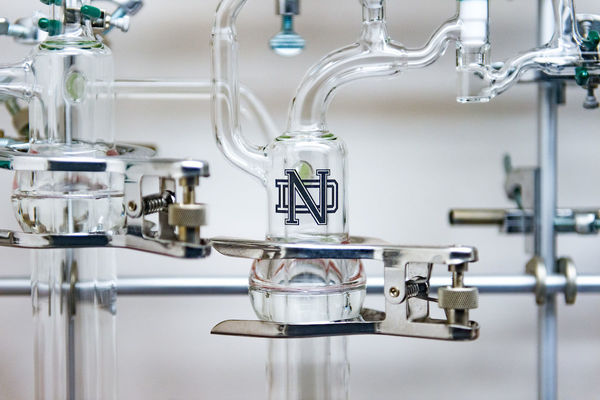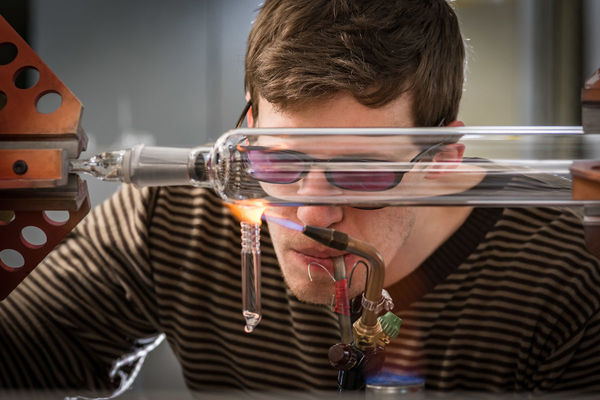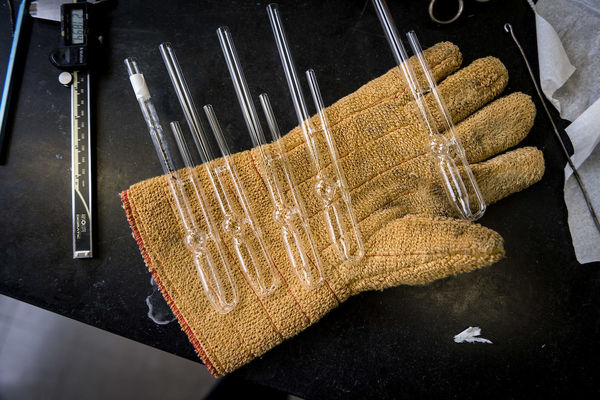
Core facility makes one-of-a-kind glass instruments to meet research needs
 Photo by Matt Cashore / University of Notre Dame
Photo by Matt Cashore / University of Notre Dame
When thinking about scientific discoveries, many do not consider the devices or instruments it takes to complete the research. However, the University of Notre Dame’s Radiation Laboratory’s Scientific Glassblowing Shop (RLSG) offers a distinctive service that helps advance research in the areas of drug discovery, physics, and more.
The Scientific Glassblowing Shop works with researchers in the design and fabrication of specialty scientific apparatus, as well as to repair or modify existing glassware for specific needs. Fully equipped to handle all kinds of glassware, the shop also has the capacity to fabricate quartz and borosilicate glassware. The RLSG serves the Notre Dame community, as well as other academic institutions and companies.
Kiva Ford is the University’s resident scientific glassblower, as well as program manager of the RLSG. In discussing his work to support research at Notre Dame, Ford said, “In the shop I create glassware that requires quality control while using materials that are not always available through mass production. Sometimes products are used in conjunction with lasers or are as small as a millimeter in diameter, but each item is customized to meet a specific need.”
 Photo by Matt Cashore / University of Notre Dame
Photo by Matt Cashore / University of Notre Dame
Ford’s work is pivotal to many studies, including a research project with Randy Ruchti, professor of physics, and Barry Baumbaugh, professional specialist of high-energy physics. Ruchti and Baumbaugh came to the RLSG to discuss the creation of extremely small quartz detection tubes to be used for experiments at the CERN Large Hadron Collider, the world’s largest and most powerful particle accelerator.
“When meeting with the Scientific Glassblowing Shop, we were not sure whether it was even possible to create what we were asking for and the time pressure for a proof-of-principle demonstration was one-week’s notice,” said Ruchti. “The detection elements produced by Ford in the shop were essential to our research, resulting in the bespoke quartz devices we needed.”
In this instance, the quartz capillary detection tubes were to be filled with a fluorescent (waveshifting) fluid and then sealed. To accommodate possible expansion and contraction of the fluid under temperature changes, a small expansion reservoir had to be blown into the capillary before liquid filling. The fluorescent light was to be detected from one end; this end had to be sealed with a ruby quartz filament and then optically polished at 90 degrees. The whole fabrication, liquid-filling, and final fusion sealing was the kind of project that could only be made by hand in a shop like the RLSG.
 Photo by Matt Cashore / University of Notre Dame
Photo by Matt Cashore / University of Notre Dame
“The Glassblowing Shop is one of several facilities that allows the Notre Dame Radiation Laboratory (NDRL) to enhance knowledge, understanding, and utilization of the effects of ionizing radiation on chemical systems,” said Ian Carmichael, director of the NDRL and professor of chemistry and biochemistry. “Our in-house expert scientific glassblowing capability enables design and construction of many key components that are crucial for successful experimentation.”
The RLSG is a part of the University’s Radiation Laboratory and is the only one of its kind in the region. The shop offers a multitude of services including grinding, drilling, glass to metal seal work, evacuating of glassware, and more, while Ford is also available for consultation on the construction, design, or application of custom glassware.
The Notre Dame Radiation Laboratory is a Notre Dame Research Core Facility supported by the Division of Chemical Sciences within the Office of Basic Energy Sciences at the U.S. Department of Energy, through a cooperative agreement with the University of Notre Dame. To learn more about the Radiation Laboratory and the Scientific Glassblowing Shop, please click here.
The images seen in this story were also featured in the summer issue of ND Magazine. To see more photos, please click here.
Contact:
Brandi Klingerman / Research Communications Specialist
Notre Dame Research / University of Notre Dame
bklinger@nd.edu / 574.631.8183
research.nd.edu / @UNDResearch
About Notre Dame Research:
The University of Notre Dame is a private research and teaching university inspired by its Catholic mission. Located in South Bend, Indiana, its researchers are advancing human understanding through research, scholarship, education, and creative endeavor in order to be a repository for knowledge and a powerful means for doing good in the world. For more information, please see research.nd.edu or @UNDResearch.